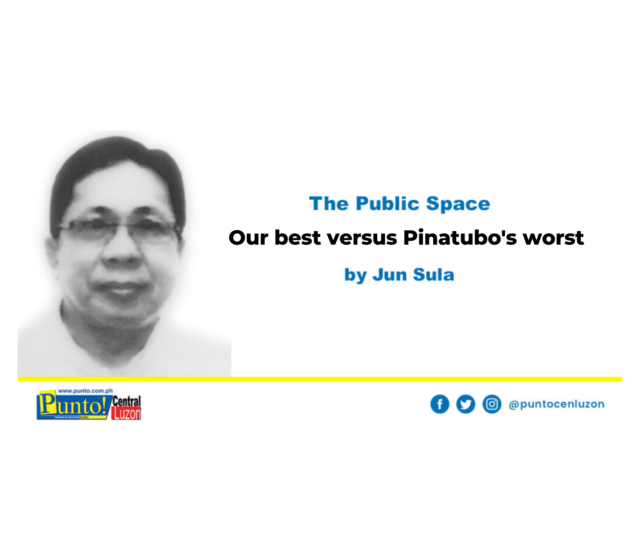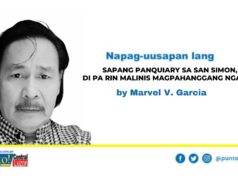One of the favorite vignettes of the late Levy P. Laus everytime the subject of Pinatubo crisis came up in private, almost nostalgic, conversation is how he made a covenant with his top managers at the height of the calamity.
“I met with my people and I struck a deal with them”, he would intensely recall. “You take care of our business in the meantime while I take care of our city (San Fernando) against the humongous threat of lahar to our community.”
With his growing business concern pushed aside to give way to the more pressing problem of lahar inundation closing in from its borders with nearby Bacolor, Laus brought together civic-minded businessmen and other political leaders to form what is now the historic Save San Fernando Movement.
With a life or death sense of urgency, the group cobbled up a cohesive plan that would provide an alternative solution to what was then a knee-jerk official reaction to what was happening in Pampanga following the worst eruption of Mt. Pinatubo. The official line then was,’ let nature take its course’, meaning allowing lahar to bury the province, or most it anyway, under lahar avalanche. There was even word that the whole Pampanga community might be transferred to somewhere in Nueva Ecija.
Neither was acceptable to the group. Allowing nature to take its course would mean wiping out some P100 billion in business and other assets. Transferring to Nueva Ecija or any other place would mean the end of the proud Kapampangan race. Kapampangan diaspora was ruled out, at all cost.
In the coming days, Laus and company would mobilize private resources and political clout to bring to bear to keeping San Fernando lahar-free. They rallied people from all walks of life to contribute to a fund-raising they launched to build a mini-dike to wall off the unabated flow of lahar and stop it on its deadly track. Except from some occasional breaches here and there, the mini-dike served its purpose.
Laus transformed its newly established radio station as the source of information to warn lahar-threatened areas and to coordinate relief and rescue operations when lahar struck vulnerable communities in the province.
It’s amazing how the group meshed like a fine-tuned tool, leadership wise, despite the presence of heavyweights like Congressman Oca Rodriguez, Gov. Lito Lapid, San Fernando Mayor Rey Aquino, even former Gov. Bren Z. Guiao. There was no political or social hierarchical issue or pecking order that would have upset the apple cart, so to speak. Everyone deferred to Laus’s embracing leadership. For instance, when Laus scheduled a meeting, everyone one would make themselves available, despite equally important engagements.
There was an overriding common goal, and everybody wanted their skin in the game.
The most important objective of the group, however, was to build a permanent concrete megadike to stop lahar, once and for all, from overflowing into San Fernando and other nearby areas. The project would cost billions of pesos, and neither the local business sector nor the local governments had that kind of money. They had the will, not the means. The only possible source of the much-needed fund was the national government which looked indecisive if not reluctant to provide it at the time. The late Sen. Blas Ople eloquently addressed the moral debate when he suggested that Mt. Pinatubo be transferred to Cebu.
One time, when the group appeared hopeless about their dream dike, the late Eddie Chua suggested that the group seek the help of Guiao who was then the chairman of Kabisig People’s Movement, a brainchild of former President Fidel V. Ramos. Chua turned to me and asked me to call Guiao. Guiao told me to accompany the group to the Kabisig office near Malacanang. Later, he brought them to office of then Budget Secretary Salvador Enriquez who gave hope the anti-lahar infrastructure they had in mind could be financed through government savings.
Enriquez’s unequivocal assurance bouyed up the spirit of the “men in green” — a nom de guerre for the Save “warriors”, because of their green uniform. To this day, I’m not sure if Guiao’s quiet efforts to make the megadike a reality has ever been acknowledged. There was a time the so-called “unsung heroes” of the Pinatubo struggle were honored publicly, certificate and all, I wonder if there was one for Guiao. There was even an faint attempt to malign Guiao’s political motive for his efforts.
While the megadike was under consideration, there was an opposition from a Ramos Cabinet man, now in Duterte’s Cabinet, who said the arguments for the project were contrafactual. Were it not for the firm stand of then Public Works Secretary Gregorio Vigilar, the project would have been scuttled.
Eventually, Ramos approved the megadike’s construction, and Pampanga was protected from lahar devastation.
Some lessons can be learned from this struggle that can be applied in public crisis management.
One, the national government sometimes can be wrong about its solution to a local problem. The local people a nd leaders probably know better. Problems, like politics, are oftentimes local.
Two, the best leaders are sometimes not elected but rise to the occasion naturally. Cinderellas do not always emerge from a midnight dance party but from a nightmarish situation.
Three, in a perfect storm, efficient and effective communication is critically important to align everyone to the common objective, whether it’s about raising money or building a structure. Clarity is important to credibility.
Four, everyone has to make a sacrifice, whether it’s pride, position, power, privilege or profit, to ensure that what’s ultimately vital to the good of all is achieved.
Five, once success is achieved, credit must be given to whom it is due. Ownership must be corporate as much as responsibility is.
As a footnote, after the megadike was built and life was slowly coming back to normal, Laus transformed the “Save” to what is now known as the Pampanga Chamber of Commerce and Industry or PAMCHAM. By this time, he had taken over the steering wheel of his business and was looking forward to a much better time for Pampanga and San Fernando. He predicted progress rising from the ashes, never ever seen before Pinatubo and, were it not for this recent pandemic, would have gone further to greater heights. And he was the first to put his money were his mouth or mind was.
Laus died a year ago from a tragic helicopter crash. His legacy is immense, both for his trenchant vision and the sustaining viability of Pampanga and the countryside.Might his personal mission had been that and he’d done it well? ( He used to complain that he had the job of a 60 year-old man all wrapped up in 20 years of his adult life).
The commemorative holiday for the Pinatubo eruption last June 15 should be a tribute to all those who had all their hands deck to overcome a great catastrophe. Pinatubo gave its worst but the Kapampangans gave their best. It’s consistent with the province’s historical greatness as one of the first eight provinces to rise against colonial Espana.





